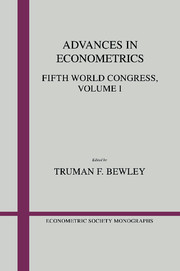Book contents
- Frontmatter
- 1 Specification testing in dynamic models
- 2 Specification tests: an overview
- 3 Kernel estimators of regression functions
- 4 Identification and consistency in semi-nonparametric regression
- 5 On econometric models with rational expectations
- 6 Calculating asset prices in three example economies
- 7 The Kalman filter: applications to forecasting and rational-expectations models
- 8 Applications of the Kalman filter in econometrics
8 - Applications of the Kalman filter in econometrics
Published online by Cambridge University Press: 05 January 2013
- Frontmatter
- 1 Specification testing in dynamic models
- 2 Specification tests: an overview
- 3 Kernel estimators of regression functions
- 4 Identification and consistency in semi-nonparametric regression
- 5 On econometric models with rational expectations
- 6 Calculating asset prices in three example economies
- 7 The Kalman filter: applications to forecasting and rational-expectations models
- 8 Applications of the Kalman filter in econometrics
Summary
Introduction
From the point of view of econometric modelling, the Kalman filter is of very little interest. It is simply a statistical algorithm that enables certain computations to be carried out for a model cast in state space form. The crucial point for the econometrician to understand is that the state space form opens up the possibility of formulating models that are much wider and richer than those normally considered. Furthermore, it often allows the setting up of models that have a more natural interpretation and provide more useful information on the nature of underlying economic processes. This second point can be illustrated clearly at the simplest level of a pure time series model. Indeed, the aim of this chapter will be to show how the state space form can be used to provide a framework for modelling economic time series that is in many ways preferable to the more conventional approach based on ARIMA processes. The proposed framework links up closely with that of dynamic econometric models, and the resulting model selection methodology is much more akin to that of econometrics. Perhaps the clearest indication of the closeness of these links is that the starting point for the proposed framework is regression rather than the theory of stationary stochastic processes.
The state space form allows unobserved components to be incorporated into a model, and the Kalman filter provides the means of estimating them. The specification of these components must, to some extent, depend on a priori considerations, and since the components presumably have an economic interpretation, the model is a structural one; see Engle (1978). In the reduced form the information on individual unobserved components is not explicitly available since the disturbances that generate the various unobserved components are amalgamated into a single disturbance term. In the case of a linear univariate structural time series model, the reduced form is an ARIMA process.
- Type
- Chapter
- Information
- Advances in EconometricsFifth World Congress, pp. 285 - 312Publisher: Cambridge University PressPrint publication year: 1987
- 34
- Cited by



